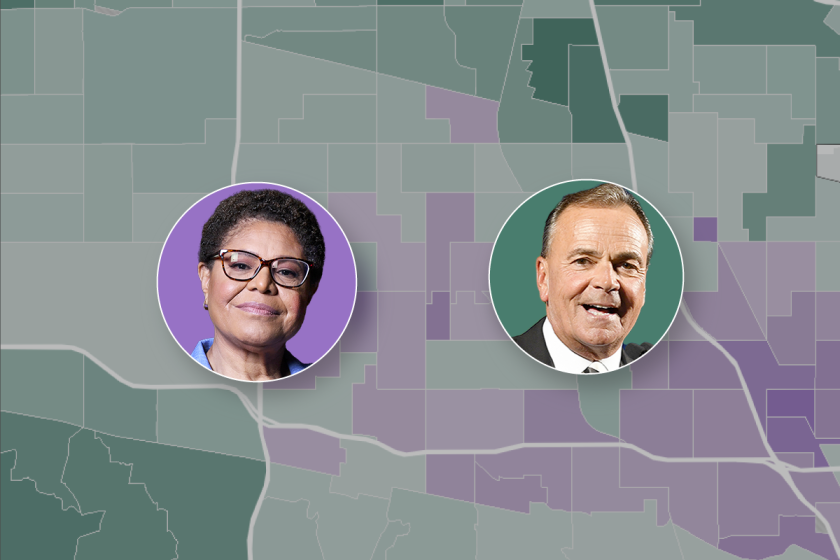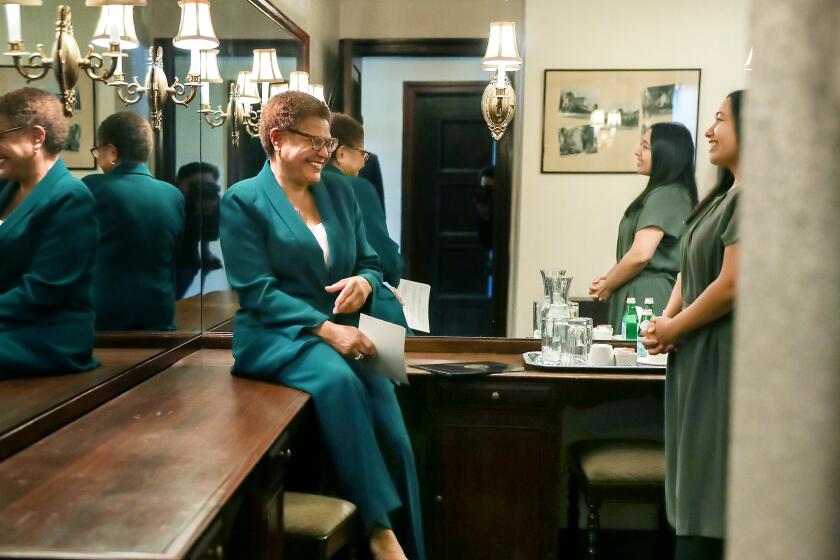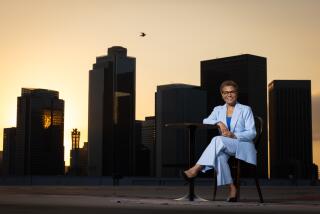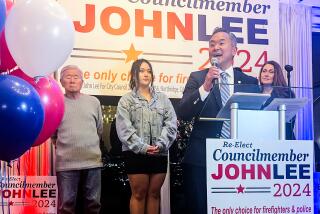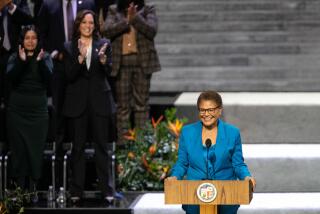Karen Bass drew more votes than any mayor candidate in L.A. history
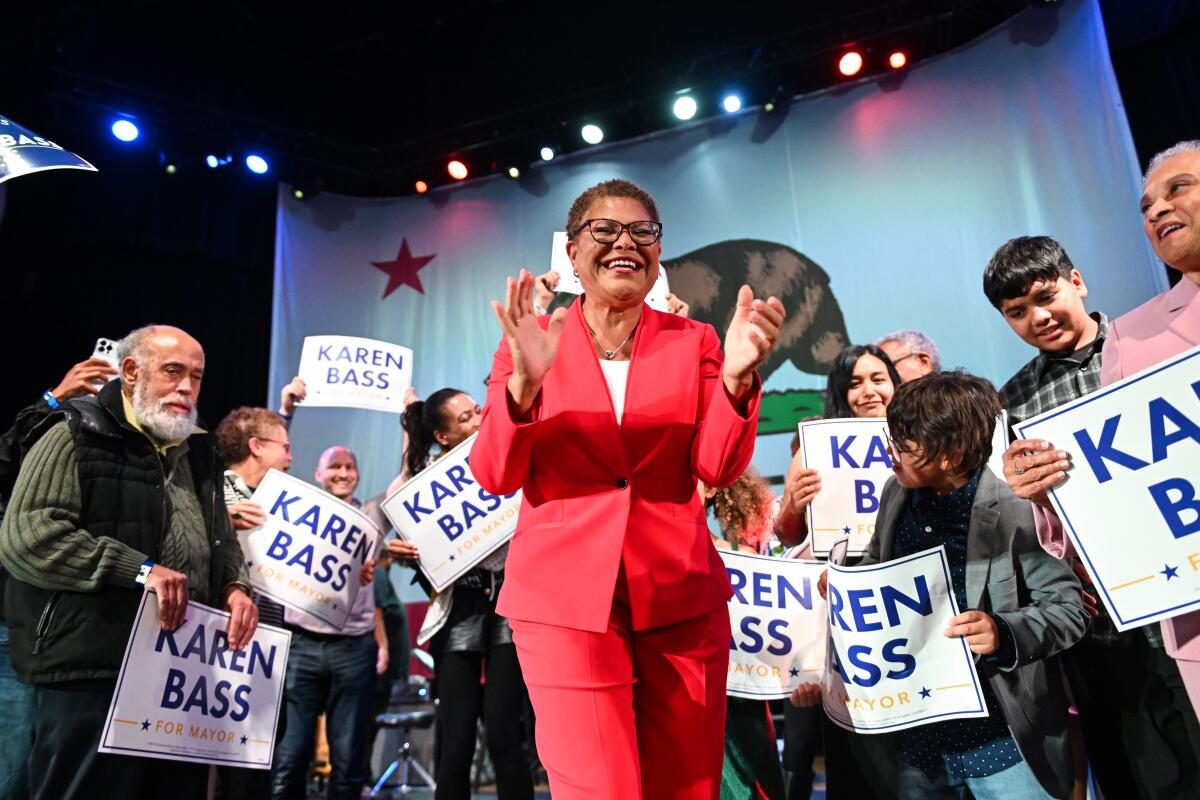
- Share via
A record number of Los Angeles voters cast ballots for mayor in this month’s election, the result of changes in the electoral calendar, the state’s easing of voter registration rules and the provocative contest between U.S. Rep. Karen Bass and businessman Rick Caruso, according to analysts and nearly complete returns from county officials.
Bass took advantage of the new political landscape to drub her rival, notching a nearly 10-percentage-point margin. Nearly 928,000 Angelenos cast votes for mayor, surpassing the previous high of 856,000 in the transformative, racially polarizing race in 1969, when the white incumbent, Sam Yorty, defeated his Black challenger, Councilman Tom Bradley.
For the record:
7:34 a.m. Nov. 25, 2022An earlier version of this article said the total number of voters who cast ballots in the Los Angeles mayor’s race stands at nearly 978,000. The correct total is nearly 928,000.
With L.A.’s population a full 1 million under the 3.8 million it is today — and the total of registered voters only half the 2.2 million of today — the 1969 race drew an astonishing 76% turnout; this year’s Bass-Caruso matchup will be about 45%, according to county election officials.
Bass made history last week when she became the first woman elected mayor in L.A.’s 241-year history. Her vote total of 508,860 as of this week is already the highest ever for the city’s top job, and is more than double the number Eric Garcetti received when he became mayor in 2013.
Los Angeles historically held elections for elective office in odd-numbered years, but voter turnout had plummeted over the last four decades — typically falling well under 40%.
So to bolster the electorate and make it more representative of the population, voters in 2018 approved a charter amendment to shift elections to even-numbered years, aligning them with races for president, governor and other high-interest offices and ballot measures.
In another proof of how election-year anomalies drive voters, the measure approving the election calendar change attracted a total of 975,000 votes, more than the Bass-Caruso showdown. Good-government evangelists might want to believe that election reform galvanized the electorate, but in reality, 2018 voters came out in a “blue wave,” largely to express disdain for President Trump.
That calendar shift gets much of the credit for the surge in voter participation in 2022, said Registrar-Recorder/County Clerk Dean Logan.
“The idea of consolidating in any given year is that you will have a lot more people turning out for votes in cities, special districts and school districts,” Logan said. “The turnout we saw this year is bearing out the intent of that policy.”
Explore your precinct level results from the 2022 California midterm election
Political consultant Bill Carrick, who has run multiple local, state and federal campaigns, agreed that this year’s vote represents an “extraordinary” voting expansion over past mayoral elections, because of the change to even-year voting but also several measures California designed to maximize voter registration.
Those include: the so-called “motor voter” law allowing millions of Californians to register merely by keeping their driver’s licenses up to date; an “automatic registration” rule that assures voters remain on the voting rolls even when they move from one county to another; a measure permitting new voters to register on election day; and more marginal reforms, like one allowing 16- and 17-year-olds to pre-register, making them automatically eligible to vote when they turn 18.
And with the pandemic-era shift to mail-in ballots being sent to every eligible voter, roughly 80% of votes were cast that way, the county reported.

Overall, white voters continued to represent by far the largest racial bloc, casting 59.6% of the ballots in the mayoral race, compared with Latino voters at 23%, Asian American voters at slightly above 9% and Black voters just under 8%, according to Paul Mitchell, an authority on voting who tracked L.A.’s results closely.
Fernando Guerra, a Loyola Marymount University political scientist, suggested that Caruso, a former Republican, needed Latino voters to represent at least 30% of voters to have a chance of defeating Bass. Pre-election polling suggested Latino voters tilted strongly toward Caruso, while the overall electorate, with nearly half identified as liberal, favored Bass even more dramatically.
“He needed to get Latinos to turn out to a much greater extent than they did and he needed to get a much higher percentage of that vote,” Guerra said. “And he didn’t do either one. He did better than most people expected, but still not enough to be able to win.”
Experts cautioned against comparing this year’s election to those from earlier eras, given that the 2022 race was the first held in conjunction with statewide voting and the first conducted with all the rules expanding voter access.
The closest parallel would be the 2013 election, in which Garcetti defeated City Controller Wendy Greuel, while receiving just 222,300 votes. The 419,000 total votes cast fall well behind Bass’ solo tally this fall, as turnout stalled at a paltry 23%.
Spiraling homelessness and a housing crisis drew considerable attention to this year’s race. But the attention could not compare to the fury and spectacle that developed in two monumental showdowns between Yorty, the populist who would later be known as “Travelin’ Sam,” for his many overseas junkets, and his challenger, Bradley, a former Los Angeles police lieutenant and the son of Texas sharecroppers.
In the 1969 contest, Yorty depicted the mild-mannered and politically moderate Bradley as a dangerous radical, and won by 6 percentage points.
Four years later, Bradley assembled an unprecedented coalition, primarily of white liberals and Black voters, to win the rematch and become the city’s first Black mayor, with turnout exceeding 64%.
Nearly half a century later, Bass awaits a Dec. 12 swearing-in to become L.A.’s second Black mayor.
A late endorsement from former President Obama, along with the Supreme Court decision striking down Roe vs. Wade, helped propel Bass to victory.
“Those elections represented such a historical marker in the entire country’s racial politics. They were very big news here and everywhere,” said Raphael Sonenshein, a Cal State Los Angeles political scientist, who wrote the definitive history on Bradley’s victory. “It’s hard to compare them to anything that has come since.”
The 45% final turnout this year will be almost identical to 1993, the last year that presented such an ideologically striking choice to voters. In an election held in the long shadow of the 1992 riots, Republican businessman Richard Riordan defeated City Councilman Michael Woo, who would have been L.A.’s first mayor of Asian descent.
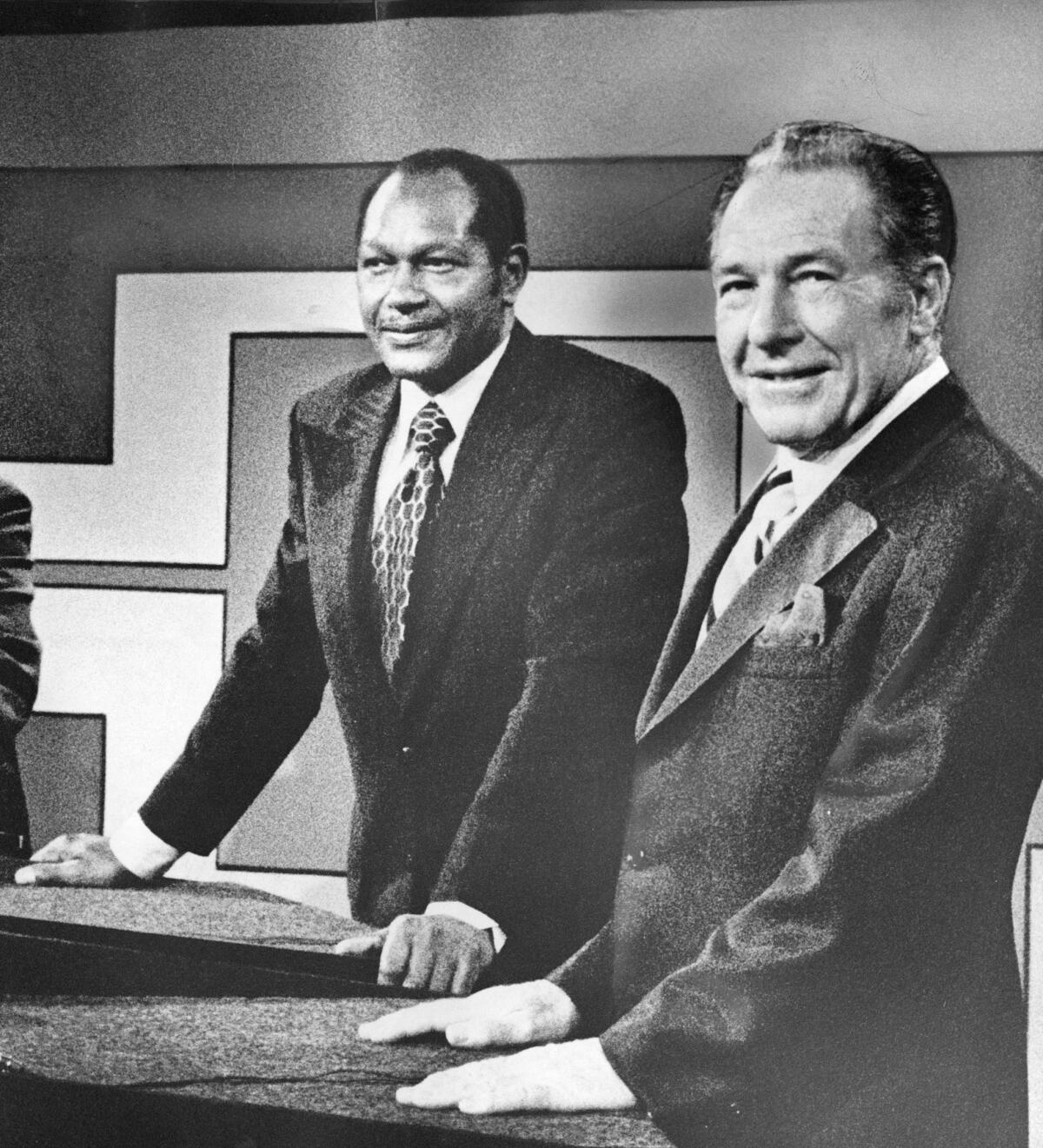
Since then, Los Angeles has gained nearly 450,000 residents while adding many more voters — just short of 780,000 — because of the expansive registration rules.
When Los Angeles moved to even-numbered years for elections, some fretted that city races would not get enough attention, as state and federal contests overwhelmed voters.
That proved not to be the case, as city voters turned out in greater numbers than those countywide and as the race for L.A. sheriff, featuring a controversial incumbent Alex Villanueva, drew far more attention than anything on the statewide ballot, with the possible exception of a measure to codify the right to a legal abortion.
“There was an argument the ballot would just be too long or there would be too many candidates and that people would be confused,” Carrick said. “Well, that all turned out to be just a bunch of BS.”
Guerra agreed: “With the turnout higher in the city, it shows that people were turning out because of the mayor’s race and competitive council races.”
More to Read
Sign up for Essential California
The most important California stories and recommendations in your inbox every morning.
You may occasionally receive promotional content from the Los Angeles Times.

